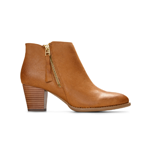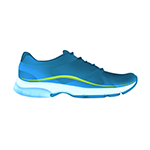
What Are Orthopedic Shoes?
 When you think of an orthopedic shoe, what comes to mind? You
might imagine more clunky, unfashionable footwear found in your grandparents’ closet. However, the word
“orthopedic” simply refers to the musculoskeletal system: the muscles, bones, joints, ligaments, and tendons
that keep your body moving.
When you think of an orthopedic shoe, what comes to mind? You
might imagine more clunky, unfashionable footwear found in your grandparents’ closet. However, the word
“orthopedic” simply refers to the musculoskeletal system: the muscles, bones, joints, ligaments, and tendons
that keep your body moving.
We’re here to set the story straight about orthopedic shoes: they’re for anyone of any age, build, and lifestyle. What’s more, orthopedics can soothe discomfort linked to a range of common injuries and conditions. Plus, you don’t have to sacrifice style when you choose orthopedic footwear.
So, do I need orthopedic shoes?
Keep reading for our comprehensive guide on what orthopedic shoes are, who should wear them, and why they are important in promoting foot health.
Orthopedic vs Traditional Shoes: What’s the Difference?
What is an orthopedic shoe? Simply put, orthopedic shoes are designed to aid or prevent foot issues, while regular shoes are made for the general public without podiatry concerns. While a high-quality shoe may share many features with an orthopedic one, several differences set them apart.
- Customization – Orthopedic shoes can often be sized and personalized to your specific needs, such as with custom orthotic insoles. However, ordinary footwear can’t be modified—everyone wears the same pair out of the box.
- Sizing – Even if they are not custom-made, orthopedic shoes often have a greater size selection to choose from, especially concerning width. Standard shoes may not have the shape or size your feet require.
- Support and cushioning – Orthopedic shoes are designed to reduce stress and pressure on the feet, so they feature enhanced arch support and shock absorption. Regular shoes offer basic protection for everyday life, but don’t go the extra mile on support.
- Versatility – There are pros and cons to the adaptability of orthopedic footwear. On the one hand, since orthopedic shoes prioritize musculoskeletal support, they may lack other functional features such as water resistance or trail tread. But at the same time, they are ideal for extended periods of standing and walking, keeping your feet comfortable all day, whereas a regular shoe may not hold up as long.
- Price – You get what you pay for, and the advanced features of orthopedic shoes can also come with a higher price point. Non-orthopedic shoes tend to be priced a bit lower, depending on the brand and retailer and are also more widely available.
Keep in mind that even if your shoe is comfortable, that doesn’t mean it’s orthopedic—you may simply be masking an underlying problem with a cushy footbed. You can explore different types of shoes to gain a detailed understanding of various shoe types and their suitability.
Who Should Wear Orthopedic Shoes?
So, now that you know what an orthopedic shoe is, you may still be wondering who should wear it. The short answer? Anyone. The long answer is that the best orthopedic shoe can help provide extra comfort, promote foot realignment and more. Many issues can start to improve thanks to a pair of orthopedic shoes.
Plus, orthopedic shoes promote long-term foot health. Even if you are not dealing with a serious health issue, orthopedic footwear can be used as a preventative measure for underlying conditions or everyday injuries.
Those with Foot Pain
If you have been consistently wearing shoes that don’t fit or cause an unnatural foot position, you’re more likely to develop discomfort or pain. This could range anywhere from uncomfortable swelling to immobilizing pain. Orthopedic shoes give your feet a relieving reset, allowing your body to realign, regain balance, and adjust to its natural walking gait.
Consider this: the CDC recommends taking at least 10,000 steps a day. You may already be trying to reach this daily step count on a wristband fitness tracker. Think about the prolonged discomfort of taking 10,000 steps every day in an ill-fitting, uncomfortable, or unnatural foot position. That’s 70,000 steps a week, roughly 300,000 a month—steps that could be supported by orthopedic shoes.
Those with Foot Conditions and Medical Issues
Orthopedic shoes are a common remedy for a range of conditions. The wrong pair of shoes can not only harm your feet, but also cause a ripple effect on your ankles, knees, hips, and back.
Orthopedic shoes and orthotic insoles can be used to soothe a range of symptoms surrounding:
- Flat feet – Extremely low arches
- High arches – Unnaturally raised arches, known medically as cavus foot
- Plantar fasciitis – Ligament inflammation causing heel pain
- Diabetic neuropathy – Nerve damage caused by diabetes, leading both nerve pain, poor circulation, or lack of sensation in the feet
- Arthritis – Swollen, painful, or stiff toe joints
- Bunions – Painful bumps that form on the big toe joint
- Hammertoes – A deformity in the middle toes, in which toes bend in the shape of a hammer
- Heel spurs – A painful or swollen excess bone growth on the heel
- Bursitis – Inflamed fluid sacs in foot joints
- Lower back pain – Curved spine (lordosis) or poor posture caused by unnatural foot positioning
Some of these foot conditions are genetic, while others are caused by an underlying condition or can develop over time. If you are at risk, experts often recommend orthopedic shoes as a preventative measure. (And a pair of shoes is a lot cheaper than major surgery, after all.)
Be sure to consult with your doctor or a healthcare provider to decide if orthopedic shoes are right for you and your unique circumstances.
Those with Active Lifestyles
Day-to-day routines also play a role in foot pain or conditions. You can turn to
the benefits of orthopedic shoes based on your:
- Profession – Depending on your job, you may be standing or walking on your feet all day. Orthopedic shoes help relieve pressure and maintain balance throughout long shifts.
- Activity level – Power walkers, runners, hikers, and dancers will all have different footwear preferences, but share a common need for arch support, shock absorption, recovery, and more.
- Age – You only get one set of feet, so it’s important to take care of them to avoid problems down the line. Orthopedic shoes can support your foot health and the rest of your body’s alignment, removing harmful strain from your joints and bones.
Keep in mind that all feet have unique needs and risk factors, so talk to your podiatrist or doctor about your particular lifestyle and how orthopedics fit in.
Key Features of Orthopedic Shoes
What do orthopedic shoes do? Orthopedic shoes are designed with a range of special features to keep feet comfortable, supported, and healthy. When searching for supportive shoes, here’s what to look out for:
- Superior arch support – Whether you are struggling to figure out how to fix flat feet or relieve high arches, orthopedic shoes help realign your natural walking pattern.
- Enhanced shock absorption – High-quality shoe cushioning absorbs the shock that comes from your foot hitting the ground. Without it, you can cause serious damage to your joints.
- Wide toe box – More than just extra space to wiggle your toes, an ample toe box allows you to comfortably wear shoes despite bunions, hammertoes, or inflammation.
- Adjustable width – In addition to various width options (narrow, medium, wide), orthopedic shoes can often be loosened or tightened with laces or straps to account for fluctuating inflammation.
- Breathable material – Lightweight yet protective fabric is crucial for all-day comfort and airflow. Keeping feet dry can also help minimize swelling. Taking into consideration shoe sole material is just as crucial to protecting your feet.
- Removable insole – With orthotics, removable is code for customizable. Insoles are important in all shoes, but especially in orthopedic footwear, for comfort and flexibility. From medically prescribed footbeds to Vionic’s Orthotic Insoles, an interchangeable model is the most versatile option.
Can’t standard footwear have some of these characteristics, too? Sure—but not to the extent or quality of orthopedic shoes.
Why Orthopedic Shoes Matter
All these features showcase the benefits of orthopedic shoes, clearly delineating them from ordinary shoes. But what exactly do orthopedic shoes do?
Whether you’re using them preventatively or to treat an issue, orthopedic shoes have the potential to:
- Increase comfort
- Support posture
- Reduce pressure on joints
Now all that’s left is picking out the perfect pair.
Choosing the Right Orthopedic Shoes
Your ideal orthopedic shoe depends on a number of factors. For instance, if you’re trying to soothe chronic heel issues like plantar fasciitis or heel spurs, you need the comfort of a deep heel cup. For painful joint issues such as bunions or other growths, a wide toe box is essential.
At Vionic, we have our own proprietary technology up our sleeves—or should we say, in our soles.
- VIO MOTION™ Technology – Combining shock absorption, contoured arch support, and deep heel cups, these footbeds promote healing and recovery. Check out VIO MOTION™ in the Awaken Recovery Sandal, featuring four colors of stylish leather straps.
- EVA footbeds – Textured or molded footbeds, as found in the Tide RX Recovery Sandal, provide massaging relief to sore feet. Experiencing the difference in EVA shoe material first hand can help you appreciate why these footbeds are so effective in delivering comfort and support.
- Vio Flex insole – This flexible and lightweight footbed is ideal for active shoes like the Walk Max Lace Up Sneaker. The cushioning, stability, and moisture control are perfect for power walking and running errands alike.
With these orthopedic properties and more, Vionic footwear goes the distance for foot health.
Step Better with VIO MOTION™ from Vionic
Who said comfortable shoes aren’t stylish, trendy, and totally envy-inducing? Shoes like orthopedics that prioritize comfort can look great while they feel great. That’s what we’re all about at Vionic.
Our proprietary VIO MOTION™ technology combines orthopedic science with movement and stability. The result? A shoe that accounts for full-body balance.
And for those who need increased foot support, we have the orthotic insoles you need to make any of your favorite pairs an orthopedic shoe—with increased cushioning, stability, and arch support.
From daily walking sneakers to essential recovery shoes and everything in between, our versatile footwear is designed to enhance movement from toe to heel. Browse our collection today—your feet will thank you.
Sources:
Medical News Today. What is orthopedics, and what do orthopedists do? https://www.medicalnewstoday.com/articles/what-is-orthopedics.
Beltsville Foot and Ankle Center. 7 Healthy Foot Benefits Of Orthopedic Shoes. https://www.beltsvillefootcare.com/blog/7-healthy-foot-benefits-of-orthopedic-shoes.
Beltsville Foot and Ankle Center. 7 Conditions You Can Improve With Custom Orthotics. https://www.beltsvillefootcare.com/blog/7-conditions-you-can-improve-with-custom-orthotics.
Centers for Disease Control and Prevention. Opportunities for Increased Physical Activity in the Workplace: the Walking Meeting (WaM) Pilot Study, Miami, 2015. https://www.cdc.gov/pcd/issues/2016/pdf/16_0111.pdf.
Cleveland Clinic. High Arch Feet. https://my.clevelandclinic.org/health/diseases/21719-high-arch-feet.
New York Bone and Joint Specialists. What Makes a Good Pair of Orthopedic Shoes? https://nyboneandjoint.com/blog/good-pair-orthopedic-shoes/.









